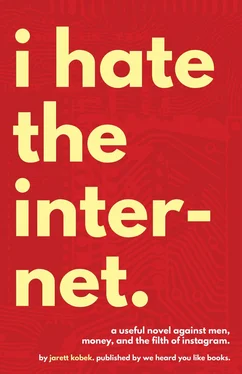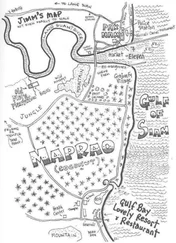This theoretical 45 year old man dressed as Thor will wander through the post-Brutalist architecture of the San Diego Convention Center. As he walks its white hallways, passing beneath its curved glass, people will approach the 45 year old man and speak with him as though he is Thor.
They will say, “Hi, Thor!” They will say, “Hey, Thor! How’s it going?” They will ask, “Yo, Thor, how’s the hammer hanging?”
They will pose for photographs with the 45 year old man. They will later post these photographs to Facebook and Twitter. They will ask for Thor’s opinions on matters large and small. The 45 year old man will answer these questions in character.
In the liminal zone of the comic book convention, trapped within the magick circle of cosplay, it will be impossible to determine whether this 45 year old man has any conception that he is not, in actuality, the intellectual property of a major corporation.
Whenever Adeline attended a comic book convention and encountered cosplay, she was sure that she was witnessing the ultimate state of late period capitalism.
People who spent their leisure time tweeting and creating intellectual property for Twitter were going out into the world and dressing themselves as the intellectual properties of major international conglomerates.
They had transformed their bodies into walking advertisements for entities in which they had no economic stake. These advertisements would later appear in photographs on Facebook and Twitter and Instagram and Tumblr and Pinterest and Flickr and be collated on advertising supported websites like Newsarama and io9 and The Mary Sue.
Brand identity was complete.
Anyway, that was Twitter in 2013. A system designed to tell Adeline that she should feel like shit via short messages from people who believed Batman was real.
These lessons in ethics and morality were conveyed through computers and cellular phones built by slave labor in China.
But Twitter was only the symptom. The Internet was the disease.
The Internet was an excellent way to distribute child pornography, stolen autopsy reports and pirated copies of 1970s Euro Horror. It was also the dominant method of recorded communication in the early Twenty-First Century.
Despite the Internet’s tyrannical reign over billions of people, very few of those billions understood how the technology worked. These billions were subject to a complex mechanism about which they knew nothing and over which they had no control.
Very few cared that they didn’t understand the complex mechanism. They had been inoculated against any such concerns through repeated exposure to another complex mechanism about which they knew nothing and over which they had no control.
This other complex mechanism was called governance , an organizing principle used by societies to determine which individuals were granted homes on higher ground and which individuals were forcibly executed.
Many of the pointless men who built the Internet had done so under the delusion that their complex system could exist as a check on governance .
These pointless men believed that freedom of speech and freedom of expression were necessary to the functioning of a society and thus designed the Internet to prevent governance from impeding the free flow of discourse.
This wonderful fantasy disappeared around the time that another, more powerful fantasy took hold in the minds of the useless men who worked in technology. The second fantasy was money.
The men who championed money recognized that a platform where any old asshole could say any old bullshit was a zone without any rules of discourse. A lie was as powerful as the truth.
This made the Internet a wonderful place to advertise.
The champions of money understood that the best advertisements were those that involved a degree of interactivity with an audience. Here, too, the Internet, with its emphasis on freedom of expression and freedom of speech, proved its worth.
A popular delusion in the Twenty-First Century was the belief that new technologies, which appeared every day, were neutral arrivals.
The thinginess of each thing was wrested from the field of Forms and brought into the world through nerdy Parthenogenesis.
But all technology was the product of its creators’ spoken and unspoken ideologies. The Internet was not a neutral environment dedicated to freedom of speech .
It was something else, the result of paranoid Cold War thinking mixed with hazy San Francisco Bay Area notions like the idea that enlightenment could be achieved through sustainable polar fleece and organically grown fruits.
The Internet was bad ideology created by thoughtless men.
Consider, in contrast, the camera, another supposedly neutral technology which also become an arbiter of truth. If something was captured by the camera’s lens, then it was true, then it had happened. Everything else was lies.
The camera was invented by middle class French men during a period of extensive Colonial expansion. Thus the camera operated, in perpetuity, on the spoken and unspoken ideologies of Nineteenth Century France.
The camera was very good at capturing sexualized images of women and even better at capturing dehumanizing images of poor people and people with eumelanin in the basale strata of their epidermises.
The Internet was a heaping mass of ideologies, spoken and unspoken, that reflected the social values of its many creators. Some of these men believed in freedom of expression. Some of these men were afraid of the Russians. Some of these men believed in nothing but money.
The system was designed with the sole purpose of maximizing the amount of bullshit that people typed into their computers and telephones. The greater the interconnectivity, the greater the profits. It was feudalism in the service of brands, and it rested on inducing human beings to indulge their worst behavior.
This was the world into which Adeline had wandered.
A place where complex systems gave the mentally ill the same platforms of expression as sane members of society, with no regard to the damage they caused to themselves or others. A place where complex systems induced the destruction of human beings like Ellen Flitcraft with no purpose other than making money for Google and Facebook.
Alas for the men who had designed the Internet whilst enthralled by Ayn Rand and shitty Science Fiction, it turned out that an open forum of ideas was impossible when the vast majority of vocal users were no more than babbling shit-asses.
What could Adeline do? How do you reason with people who believe that Thor is real? How do you reason with people who make arguments about human dignity on machines built by slaves in China? How do you reason with people whose primary expression comes pre-branded by Twitter?
So she played the game. She was tweeting. Her first week went well. Kids were asking her for advice.
Then the most important kid reached out.
Emil called her.
Emil was Adeline’s son. He was nineteen years old. Emil was estranged from Adeline. Emil lived in Los Angeles with Suzanne, Adeline’s alcoholic mother who had been an extra on the television show Gidget.
Emil was attending CalArts, an arts university founded by Walt Disney. Emil was working towards a Bachelor of Fine Arts.
Emil was not an expected pregnancy.
Adeline got knocked up back in 1993, while she lived with Jeremy and Minerva on Steiner in the Lower Haight. Her bed was a couch in the living room.
The man who impregnated Adeline was born Nasir Mahmoud but called himself Nash Mac. He had a moderate amount of eumelanin in the basale stratum of his epidermis.
Читать дальше












